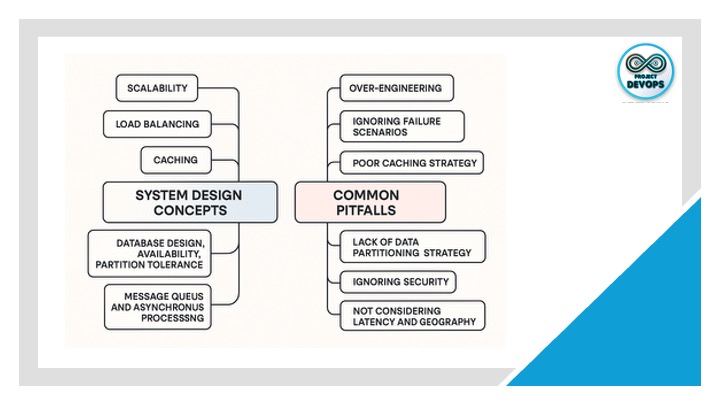System Design Concepts and Common Pitfalls You Must Avoid

System design is the art of defining the architecture, components, and interactions that allow software systems to scale, perform efficiently, and remain reliable. Whether you are preparing for a system design interview or building production-grade systems, understanding key concepts—and the common mistakes to avoid—can make all the difference.
Core System Design Concepts
1. Scalability
Vertical scaling: Adding more power (CPU, RAM) to a single machine.
Horizontal scaling: Adding more machines to handle load. This is usually more cost-effective and fault-tolerant.
Elastic scaling: Auto-scaling based on traffic spikes (e.g., AWS Auto Scaling Groups, Kubernetes HPA).
👉 Key takeaway: Always design with elasticity in mind—systems should gracefully handle sudden traffic bursts.
2. Load Balancing
Distributes requests across servers.
Improves fault tolerance and performance.
Popular strategies: Round-robin, least connections, consistent hashing.
👉 Best practice: Combine load balancers with health checks to avoid routing traffic to dead servers.
3. Caching
Reduces database load and improves response times.
Can be applied at multiple layers: client-side, CDN, application, or database.
Tools: Redis, Memcached, CDN providers (Cloudflare, Akamai).
👉 Best practice: Implement cache invalidation policies carefully; stale data can break user trust.
4. Database Design
Relational DBs (MySQL, PostgreSQL): Great for ACID transactions.
NoSQL DBs (MongoDB, Cassandra): Great for unstructured or high-velocity data.
Sharding: Distributing data across multiple databases for scale.
Replication: Multiple copies of the same data for availability.
👉 Best practice: Always define your query patterns before choosing the database model.
5. Consistency, Availability, Partition Tolerance (CAP Theorem)
In distributed systems, you can only optimize for two of the three:
Consistency: All nodes show the same data.
Availability: Every request receives a response.
Partition Tolerance: System continues working despite network failures.
👉 Key decision: For example, banking systems prefer consistency, while social media feeds may prefer availability.
6. Message Queues and Asynchronous Processing
Tools like Kafka, RabbitMQ, or SQS decouple producers and consumers.
Essential for event-driven architectures and handling spikes without overloading services.
👉 Best practice: Use dead-letter queues to handle failed messages gracefully.
7. Monitoring and Observability
Logs, metrics, and tracing (ELK, Prometheus, Grafana, Jaeger).
SLOs, SLIs, and SLAs define expectations for performance and reliability.
👉 Key tip: "If you can’t measure it, you can’t improve it."
Common Pitfalls in System Design
❌ 1. Over-Engineering
Jumping straight to microservices, Kubernetes, or complex sharding strategies for a product that doesn’t need them yet.
✔️ Start simple, evolve the system when scaling demands it.
❌ 2. Ignoring Failure Scenarios
Assuming databases, APIs, or servers will never fail is a classic mistake.
✔️ Always design with retries, timeouts, circuit breakers, and graceful degradation.
❌ 3. Poor Caching Strategy
Caching everything without invalidation leads to stale data.
Not caching enough can overload your DB.
✔️ Identify hot paths and apply caching selectively.
❌ 4. Single Points of Failure (SPOF)
Relying on one load balancer, one database node, or one data center.
✔️ Build redundancy at every critical point.
❌ 5. Lack of Data Partitioning Strategy
Designing without considering how the data will scale leads to huge bottlenecks later.
✔️ Use sharding and partitioning early if you expect massive growth.
❌ 6. Ignoring Security
Storing passwords without hashing.
Exposing APIs without authentication.
No encryption at rest or in transit.
✔️ Always include security as part of the system design, not an afterthought.
❌ 7. Not Considering Latency and Geography
A global user base with a single-region deployment will suffer.
✔️ Use CDNs, multi-region deployments, and DNS routing (GeoDNS, Anycast).
Final Thoughts
System design is about trade-offs. There is no single "perfect design"—only designs that fit your requirements, constraints, and expected scale. Start simple, evolve as you grow, and always remember:
👉 “Design for failure, scale for growth, and optimize for user experience.”
Would you like me to also create a diagram-based cheat sheet (like a mind map of system design concepts + pitfalls) that you can embed in the blog post? That way, readers get both text + visuals.
Comments (0)
No comments yet. Be the first to share your thoughts!